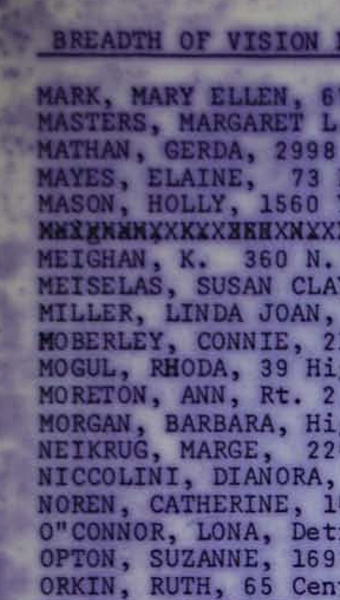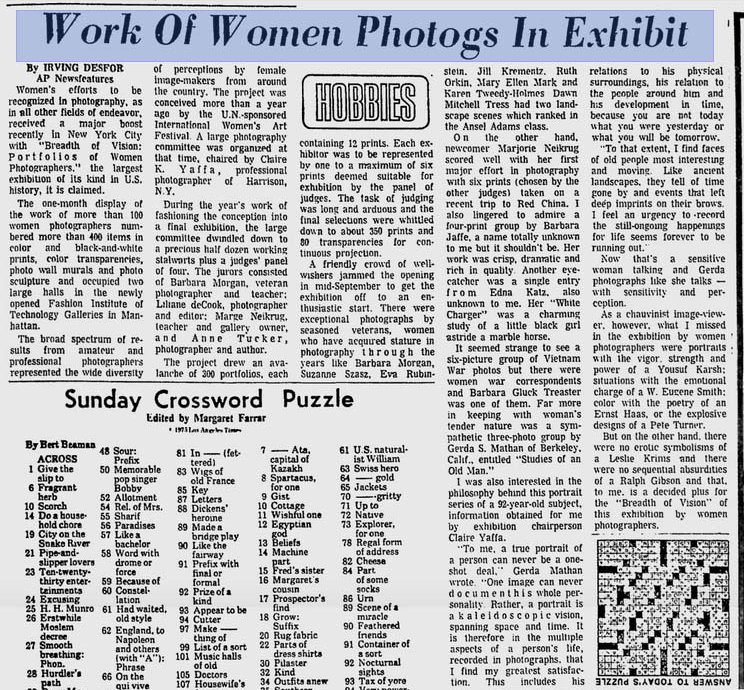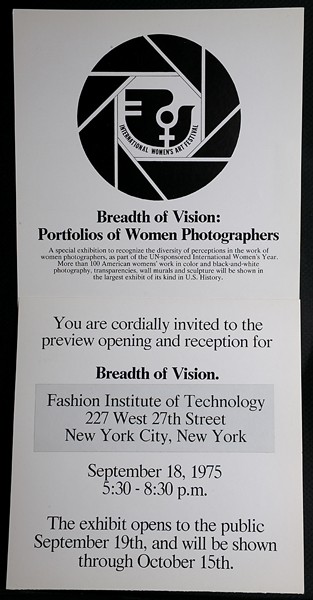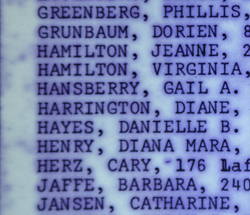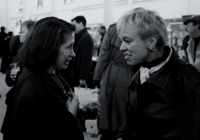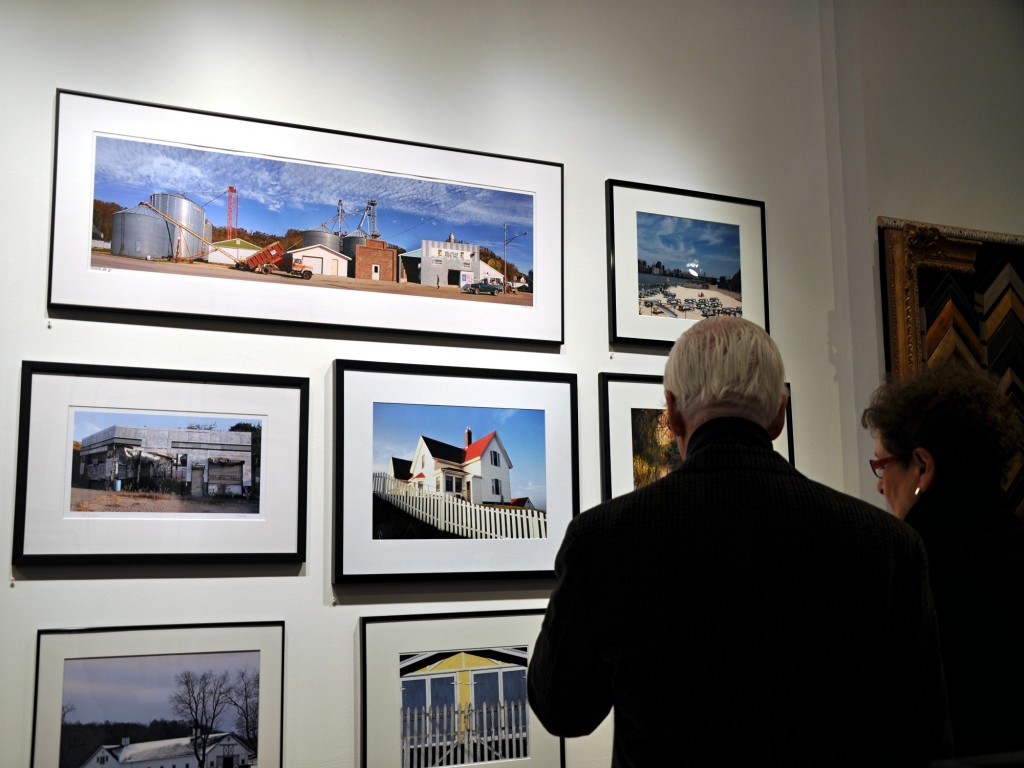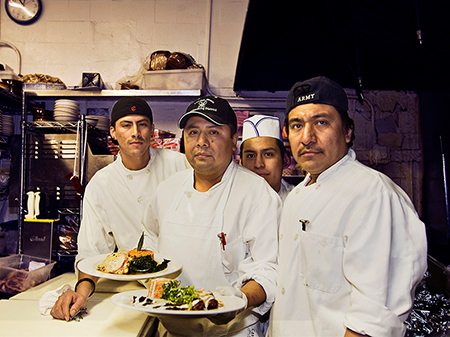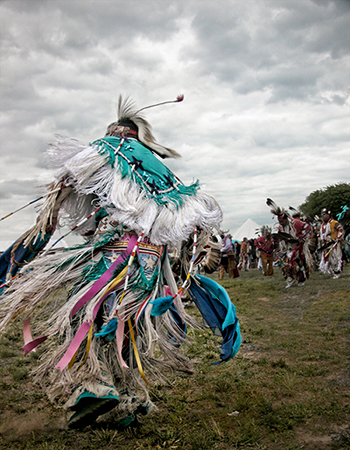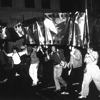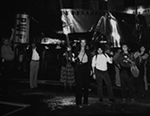Tag Archives: Breadth of Vision
30 For 30: Exhibition and Anger
To celebrate Women’s History Month, we’re featuring items from the PWP Archives* each day on this blog. In looking back, we see not only where we started, but how far photography, women, and the world have come since 1975.
Desktop publishing didn’t exist in 1975, so the roster for the FIT show Breadth of Vision: Portfolios of Women Photographers had to be mimeographed for distribution.
It was the largest exhibition of its kind at the time, and included photo luminaries like Ruth Orkin, Suzanne Opton, Mary Ellen Mark, Susan Meiselas, and Dianora Niccolini, who would become PWP’s first president.
Dismayed by the lack of press, Dannielle Hayes, one of the organizers, brought exhibitors together at ICP (then on Fifth Avenue) for a quick publicity campaign. Results included an article in the New York Herald Tribune (unfortunately under “Hobbies”), and a plan for the photographers to keep meeting. Women’s Lib was in full swing, and there was tremendous grassroots energy in the arts. Groups long excluded from exhibitions and representation were taking action for themselves. Some of the organizations founded in the 1970s include the A.I.R. Gallery, Soho Photo Gallery, and the Visual Studies Workshop (actually founded in 1969).
– Catherine Kirkpatrick
*The PWP Archives were acquired by the Stuart A. Rose Manuscript, Archives, & Rare Book Library of Emory University
Links to all the 30 For 30 Women’s History Month blogs:
Help Me Please! Hopelessly Waiting…
Exhibition and Anger
Spreading the Word
Early Ads On Paper
Cards and Letters
A Lady, a Truck, a Singing Dog
Women of Vision
A Show of Their Own
Taking It To the Street
Sisters of Sister Cities
Sold!
Education and More
Face of a Changing City
Digital Enabling
Expanding Walls and Other Possibilities
A Wonderful Life–Lady Style
Branding–the Good, the Bad, and the Ugly
The Great Change Sweeps In
PWP Goes Live!
Honoring the Upcoming
Continuity Through Change
Reaching Out
Eye a Woman Naked
Rapidly Multiplying Alternative Options
Women In the World, As Themselves
Kudos!
Friends Who Overcame and Inspired
Reversing the Gaze
Photography and More
Chicks Telling It Like It Is
Looking Back With Thanks
BOV: The Life – An Appreciation of Dannielle Hayes
BOV: The Life - An Appreciation of Dannielle Hayes
As we know, in the beginning there was a show. Fashion Institute of Technology, 1975, Breadth of Vision: Portfolios of Women Photographers, a historic exhibition out of which PWP developed. But there was another vision going on, a life and personal outlook.
Last spring I arranged to have coffee with PWP’s founder, Dannielle Hayes. There had been talk of an oral history, work on the archives, but the meeting was left casual, the topics open.
We met at a bistro near her apartment in the East Village. With close-cropped blond hair and black frame glasses, Hayes was stylish and smart, but without the “better than€ attitude that sometimes comes with accomplished New Yorkers. A sense of warmth and humor were immediately apparent; what started as a quick cup of coffee turned into a leisurely lunch.
Right here I need to come clean: the notes I took during the first twenty minutes are lost. Okay, not really lost. Nothing ever really gets lost in the house; it just goes missing for a very long time. Let’s just say they are not presently at hand. But I had my Flip camera and halfway in, begged to record. We struck a deal: if I pointed the lens away so she wouldn’t be caught chewing, I could record sound. Here is a sampling from her amazing life.
Hayes was educated at the University of Victoria in British Columbia, and Cooper Union in New York. One of her early jobs was at Fairchild Publications where she was “illustrator and writer and photographer and chief bottle washer.€ A wide range of responsibilities helped develop a wide range of skills and contacts, as well as a broad outlook. Creativity didn’t end when the shutter snapped shut; photography didn’t exist in a vacuum.
In fact, the meetings of the Breadth of Vision photographers grew out of Hayes’ concern that the show wasn’t getting enough publicity. She instinctively knew that women had to help themselves because at the time no one else would. They launched a bootstrap campaign that included taping signs to lampposts, and awareness of the show grew.
A year later, thinking way outside the box, Hayes organized a slide show called Woman Photographs Man that was shown on the back of a truck in Rockefeller Center. This attracted attention (which she primed by reaching out to publishing contacts), and she was offered a contract by William Morrow & Co. With Hayes as author/editor, Women Photograph Men was published in 1977. It was a historic book, with 100 images of men by 70 women photographers, including Arlene Alda, Barbara Gluck, Joan Liftin, Mary Ellen Mark, Barbara Morgan, Martha Swope, and Suzanne Szasz. It also contained a half folio of color photographs, unusual for the time, and an introduction by renowned film critic Molly Haskell.
Hayes was deeply involved with the project, laying it out at William Morrow, gathering and editing the photographers’ bios, and securing the top photo printer, Morgan & Morgan. “William Morrow tried to send me to some other printers and I had to look at their work,” Hayes recalled, ”and I said no,…this is not good enough. If I’m going to put my name on this book, I really want the top printer. And I…called Barbara up, [photographer] Barbara Morgan, and said ‘look, this is really important,’ and she agreed, so it was actually Morgan [& Morgan] who printed the book.€
Along with the general pressures of publishing, there were other concerns. Was the man in Patt Blue’s picture urinating or was it a stream of sunshine? Would people be scandalized by male nudity? William Morrow’s lawyer asked Hayes to sign a liability clause stating that she, not the publisher, would be responsible in case “a little blue-haired lady from the Midwest€ sued. Hayes responded that this was exactly the sort of person who would enjoy the book most, and refused to sign. Women Photograph Men came out in the fall of 1977 to excellent reviews, including one in The New York Times. No lawsuits were ever filed. Interestingly, another book with different editors, Women See Men, was published in the same year by McGraw Hill; both books had shows at the International Center of Photography.
There was also the matter of getting a photo release from Moondog, the famous street musician who was pictured in Women Photograph Men. For many years he favored a spot on Sixth Avenue at 53rd Street, but suddenly disappeared. The publishing process went on without him, and he later resurfaced, having spent ten years composing in Germany.
Not all the women photographers who gathered at Hayes’ apartment were included in the book, so she graciously bowed out as leader of the “yet unnamed PWP,” and went on to a distinguished career as a freelance photographer, writer, illustrator, and designer. But a list of Hayes’ clients (that includes Time, Inc., The New York Times, and the National Geographic Society), or the places where she’s taught photography (Canon Creativity Workshops, Simon Fraser University, the New Jersey Institute of Technology), does not even begin to indicate the wealth and richness of her ideas or the generous way in which she sees the world.
Her outlook is truly global. She once approached J. Walter Thompson, trying to put Kodak and UNICEF together, and has worked in many countries, including South Africa, Niger, Uganda, Cameroun, Senegal, Ethiopia, Tunisia, Indonesia, Jamaica, Cuba, Peru,Venezuela, Argentina and Canada. Equally impressive is her affiliation with and work on behalf of a wide range of worthy causes, including CARE, UNICEF, the United Nations’ Women’s Conference, Helen Keller International, and the 2010 Winter Paralympic Games, of which she spoke with a special fondness. The very best way to understand Dannielle Hayes is through her photographs. On her website is a movie made of her pictures from the 2010 Winter Paralympics. As a photographer, she doesn’t flinch. She simply records, without an ounce of voyeurism, and through her perception of these athletes as beautiful, gifted and heroic, we see them that way too.
There’s a saying in the piano world “you play what you are.€ Whether you’re uptight, kind, generous or mean, it all comes out in the music you make. When you look at Dannielle Hayes’ pictures, you can tell that she is filled with grace and courage and light. Hers is a beautiful life.
Her legacy? Inspiration and kindness, determination and can do. A continuing sense of awe in the face of the world and its people, and the fates that sometimes befall them. For better or worse, organizations take after their founders. In Dannielle Hayes, PWP got lucky because she was a pretty terrific place to start. For her, breadth of vision is more than the title of a show that came and went. It is very simply a way of life.
- Catherine Kirkpatrick, Archives Director
It Began with an Exhibition…
It Began with an Exhibition…
In the beginning there was an exhibition. In 1975, Breadth of Vision: Portfolios of Women Photographers opened at the Fashion Institute of Technology in New York City and galvanized a group of women to meet, share information and support each other’s projects. It was out of these gatherings that Professional Women Photographers was born.
Exhibitions have always been a huge part of the group, showcasing the diverse talents of its members. From the Me Generation at Photographics Unlimited in 1981 to Elegy for Eden at the Durst Gallery in 2007 and the upcoming Objects of Affection at Calumet Photo, there have been many evocative PWP shows that dealt with issues of the time.
This blog is going to go behind the scenes of these exhibitions, taking a closer look at some of the photographs in the shows, talking with the photographers involved, watching as the shows evolve from vague ideas to physical realities. Every picture tells a story and every photographer has a story to tell. We’re going to feature some here.
We’ll start with a look back at the PWP exhibit Americana that was on view from April 17th to May 22nd at MH Art & Framing. This show actually began its life in Queens. Last October, exhibition committee members Barbara Leven, Nancy Sirkis and D Brandon were photographing on the streets of Broad Channel, on the edge of Jamaica Bay. “It was a superb Indian summer day, warm and still with a luminous pearl-gray overcast light,” said Barbara. “I was struck by how many of the small one-family homes were decorated to the hilt with ghosts, witches, spiders and all other trappings of Halloween as well as American flags, almost to every house on some blocks.”
It was then that the theme “Americana” popped into her mind. The word itself conjures up many iconic images: apple pie, baseball games, lazy summer days in small towns. But the United States has undergone tremendous change since the nineties, and given the political upheavals and divisiveness of the last presidential election, she thought it would be interesting to explore visually what the idea meant to people today.
While typically iconic images were expected, the call for entry was left open, the unexpected invited. What emerged was an array of interpretations and an exhibition full of stories. In an effort to explore these stories further, we are introducing a feature on the blog called “What They Saw,” in which we will select images from current and past PWP exhibitions and publish the story behind the image, in the photographer’s own words. We kick off this series with Joan Katz’s Brooklyn Powwow which hung in the Americana exhibit at MH Art & Framing.
What They Saw
I attended my first Native American Pow-wow almost 20 years ago and was blown away by the colors and rhythms and voices and energy. I loved that it was open to the public – I got to experience American traditions that originated long before my family arrived here in the early 1900′s.
I shot this photo at the annual Gateway To Nations Pow-wow in Brooklyn, NY. The sky was overcast and threatening most of the day, but it never did rain. I particularly loved this dancer’s clothing – the colors were so striking against the sky, and it’s clear how much time and effort went into its creation. I used a wide angle lens to include other dancers in the background; I was struck by the strong sense of community in the group dancing, singing, and drumming, and I wanted my images to reflect some of that. – Joan Katz
- Katie Mantell, Exhibitions Director
- Catherine Kirkpatrick, Archives Director
A Trip to the Archives
Last June in a midtown rehearsal studio, amid dancers and singers warming up, the board of PWP convened for its final meeting of the year. I was new and when someone said archives, I raised my hand. Old books and pictures are passions for me. I didn’t know much about PWP and it seemed a great place to start.
But when I got over to the archives, I had second thoughts. They are in a storage facility on the west side of Chelsea, on a block with auto body shops and rough-looking folk. The building was cavernous, with green lockers reminiscent of a morgue, an elevator the size of a living room, and lights on a timer that liked to go off. It was creepy. I grabbed some stuff and ran.
Back home I examined my treasure. There were pictures of women marching in the street and showing photographs from the back of a truck. Who were they? What were they doing?
There were also announcements from shows in the 70′s and 80′s: Breadth of Vision, The Me Generation, Women of Vision. The pictures were black and white and grainy, the graphics from the early days of desktop publishing. The time wasn’t so long ago, yet everything seemed different and far away. I didn’t know what to make of it.
Slowly it dawned on me that I was looking at a slice of history. Not ancient history but recent history. There was the history of PWP itself, starting with the Breadth of Vision show at FIT in 1975. There was also the history of photography as it moved from film into the digital age, and above all there was the history of women from the 70′s on: women standing up, women speaking out, women marching and fighting for employment opportunities and rights that had long been denied.
Today we take so much for granted. We forget that chances weren’t always there. In the 1950′s my mom was an ad manager for the American Weekly, the supplement of Hearst’s New York Journal American. It was a Don Draper world and office politics were played with a gender slant. I heard over and over how men tried to put her down, cut her out, steal her work; how women had to fight twice as hard to be recognized and get ahead.
Mom got ahead and the world moved forward too. Over half of all workers now are women, and there are more women photographers than ever, represented in publications, museums and galleries around the world. But if the opportunities today seem unlimited, the fight to secure them was uncertain and hard.
Looking at these pictures and talking with some of the early women of PWP, I realized they were feisty and tough. They stood up for what they believed in, worked with what they had and took small steps. They organized and supported each other because no one else would. They found obstacles and no clear road. So they made one by walking.
In this blog I want to pay tribute to them. I want to look back at the paths they blazed and the issues they dealt with. They have lessons for all of us, and inspiration too. We have come a long, long way as photographers and women, but the road stretches on, the journey isn’t through.
- Catherine Kirkpartrick, Archives Chair



